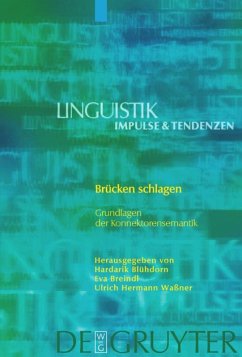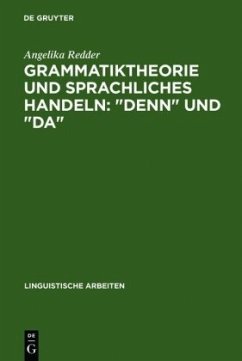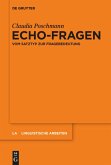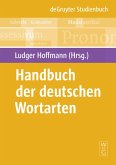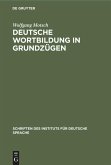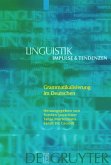A systematic description of the semantics of connectives is a challenge that linguists have yet to answer. In order to define semantic classes such as "causal", "concessive", "temporal" according to objectivizable criteria, to classify them, and to describe their relationship to one another, it is important to consider the polysemy phenomena of connectives. The interaction with syntactic, information-structural and intonational structure must also be examined. It was the goal of a colloquium at the Institut für Deutsche Sprache [German Language Institute] in December 2002 to present itself with this challenge. Their results are presented collectively in this volume. The contributions all have in common the reference to the Handbuch der deutschen Konnektoren [Handbook of German Connectives], which, with its extensive description of the syntax of connectives, offers an up-to-date starting point for a survey of semantics.
The contributions, which interactively refer to one another, are divided into four chapters. In Chapter A, interfaces are described from a grammar-theoretical, syntactic and logical viewpoint and substantiated by way of examples. Chapter B is dedicated to the temporal connectives with a focus on ambiguities (i.e. of the German connectives während, bevor, nachdem) and the establishment of the paradigms that structure the temporal field. In Chapter C, "Contrast Connectives", adversative and concessive connectives and their differentiation from one another and from additive connectives are discussed. This chapter also presents suggestions for a minimalistic, semantic description of ways of reading German aber. Chapter D is dedicated to the causal connectives. In addition to a revision of the causality concept, this chapter mainly includes suggestions for the restructuring of the causal field, for instance, through the introduction of a class mainly based on the indication of inferences.
Eine systematische Beschreibung der Semantik von Konnektoren stellt für Linguisten eine bisher nicht eingelöste Herausforderung dar: Um semantische Klassen wie "kausal", "konzessiv", "temporal" nach objektivierbaren Kriterien zu definieren, zu gliedern und ihr Verhältnis zueinander zu beschreiben, müssen Polysemiephänomene bei Konnektoren berücksichtigt und muss die Interaktion mit der syntaktischen, informationsstrukturellen und intonatorischen Struktur erfasst werden. Sich dieser Aufgabe zu stellen war Ziel eines Kolloquiums am Institut für Deutsche Sprache im Dezember 2002, dessen Ergebnisse in diesem Band versammelt sind. Gemeinsam ist den Beiträgen der Bezug auf das "Handbuch der deutschen Konnektoren", das mit seiner umfassenden Darstellung der Konnektorensyntax einen aktuellen Ausgangspunkt für die Erfassung der Semantik bietet.
Die Beiträge, die wechselseitig aufeinander Bezug nehmen, gliedern sich in vier Kapitel: In Kapitel A werden aus grammatiktheoretischer, syntaktischer und logischer Sicht Schnittstellen beleuchtet und an Beispielen konkretisiert. Kapitel B widmet sich den temporalen Konnektoren; im Zentrum stehen dabei Mehrdeutigkeiten (etwa von während, bevor, nachdem) und die Herausarbeitung von Parametern, die das Temporalfeld gliedern. In Kapitel C, Kontrastkonnektoren, werden adversative und konzessive Konnektoren, ihre Abgrenzung gegeneinander und zu additiven Konnektoren behandelt und es werden Vorschläge für eine bedeutungsminimalistische Beschreibung von aber-Lesarten gemacht. Kapitel D ist den kausalen Konnektoren gewidmet. Neben einer Revision des Kausalitätsbegriffs stehen hier vor allem Vorschläge zur Neugliederung des Kausalfeldes, etwa durch Einführung einer Klasse, die wesentlich auf der Indikation von Schlussfolgerungen beruht.
Hinweis: Dieser Artikel kann nur an eine deutsche Lieferadresse ausgeliefert werden.
The contributions, which interactively refer to one another, are divided into four chapters. In Chapter A, interfaces are described from a grammar-theoretical, syntactic and logical viewpoint and substantiated by way of examples. Chapter B is dedicated to the temporal connectives with a focus on ambiguities (i.e. of the German connectives während, bevor, nachdem) and the establishment of the paradigms that structure the temporal field. In Chapter C, "Contrast Connectives", adversative and concessive connectives and their differentiation from one another and from additive connectives are discussed. This chapter also presents suggestions for a minimalistic, semantic description of ways of reading German aber. Chapter D is dedicated to the causal connectives. In addition to a revision of the causality concept, this chapter mainly includes suggestions for the restructuring of the causal field, for instance, through the introduction of a class mainly based on the indication of inferences.
Eine systematische Beschreibung der Semantik von Konnektoren stellt für Linguisten eine bisher nicht eingelöste Herausforderung dar: Um semantische Klassen wie "kausal", "konzessiv", "temporal" nach objektivierbaren Kriterien zu definieren, zu gliedern und ihr Verhältnis zueinander zu beschreiben, müssen Polysemiephänomene bei Konnektoren berücksichtigt und muss die Interaktion mit der syntaktischen, informationsstrukturellen und intonatorischen Struktur erfasst werden. Sich dieser Aufgabe zu stellen war Ziel eines Kolloquiums am Institut für Deutsche Sprache im Dezember 2002, dessen Ergebnisse in diesem Band versammelt sind. Gemeinsam ist den Beiträgen der Bezug auf das "Handbuch der deutschen Konnektoren", das mit seiner umfassenden Darstellung der Konnektorensyntax einen aktuellen Ausgangspunkt für die Erfassung der Semantik bietet.
Die Beiträge, die wechselseitig aufeinander Bezug nehmen, gliedern sich in vier Kapitel: In Kapitel A werden aus grammatiktheoretischer, syntaktischer und logischer Sicht Schnittstellen beleuchtet und an Beispielen konkretisiert. Kapitel B widmet sich den temporalen Konnektoren; im Zentrum stehen dabei Mehrdeutigkeiten (etwa von während, bevor, nachdem) und die Herausarbeitung von Parametern, die das Temporalfeld gliedern. In Kapitel C, Kontrastkonnektoren, werden adversative und konzessive Konnektoren, ihre Abgrenzung gegeneinander und zu additiven Konnektoren behandelt und es werden Vorschläge für eine bedeutungsminimalistische Beschreibung von aber-Lesarten gemacht. Kapitel D ist den kausalen Konnektoren gewidmet. Neben einer Revision des Kausalitätsbegriffs stehen hier vor allem Vorschläge zur Neugliederung des Kausalfeldes, etwa durch Einführung einer Klasse, die wesentlich auf der Indikation von Schlussfolgerungen beruht.
Hinweis: Dieser Artikel kann nur an eine deutsche Lieferadresse ausgeliefert werden.

